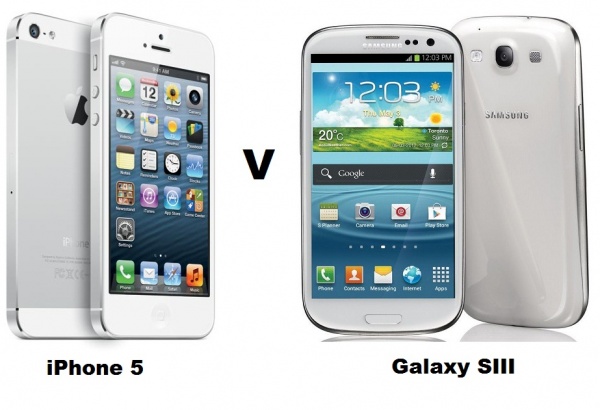With the iPhone 5 launching tomorrow in the UK we thought it was a good time to compare Apple's new device with its main competitor the Samsung Galaxy SIII.
This is the choice facing many people currently thinking about upgrading their smartphone and it's a tough call to make, so hopefully our article can help people choose between two of the best smartphones in the world !
Design and Dimensions
Apple iPhone 5 (59 x 124 x 7.6mm and 112g) v Samsung Galaxy SIII (71 x 137 x 8.6mm and 133g)
The first thing that is immediately obvious from the dimensions listed above is that Apple's iPhone 5 is smaller in every-way than Samsung's Galaxy SIII.
Those who don't like large smartphones have an easy choice to make and should go with Apple's device because it's ultra-slim, weighs a lot less and is a lot more compact overall.
However, the decision isn't as simple as it might first appear. That's because the Samsung Galaxy SIII has a huge 4.8 inch display , while the iPhone 5 has a much smaller 4 inch display. This accounts for the differences in dimensions and the larger display will definitely be favoured by some users especially those who value gaming and multimedia playback.
The other thing to consider is that Apple's iPhone 5 has a stylish and robust aluminium case, while the Samsung Galaxy SIII has a cheap plastic feel with a very thin back cover. For us there is no competition between the two in terms of build quality with Apple's iPhone coming out strongly on top.
Conclusion : 3G feels like that 4 inches is a big enough screen-size and much prefer the build-quality of the iPhone 5 to the Samsung Galaxy SIII. For these reasons the iPhone 5 is a clear winner when it comes to design and dimensions in our eyes, but those who value a larger display might think differently.
Touchscreen Displays

Apple iPhone 5 ( 4-inch IPS LCD; 1,136x640 pixels, 326 ppi) v Samsung Galaxy SIII (4.8-inch HD Super
AMOLED; 1,280x720 pixels, 306 ppi)
As we mentioned in the previous section the Samsung Galaxy SIII has a much larger 4.8 inch display compared to the iPhone 5's 4 inch touch-screen. Those favouring smartphones with huge touch-screens with love the Samsung Galaxy SIII's display and should stop reading now.
However, for the rest of us we also might want to consider the resolutions and the relative PPI's of each of the displays.
The Galaxy SIII's touch-screen runs at the higher resolution (720p), which is useful for playing back movies and watching games. However, Apple's display isn't far behind and because of the smaller screen-size actually has a higher PPI (pixels per inch) rating , which means it looks sharper to the human eye.
Conclusion
Both displays are stunning and it just comes down to whether you want a huge 4.8 inch touch-screen or are happier with the iPhone 5's sharper 4 inch Retina display.
Processing and Graphical Power !

Apple iPhone 5 (A6 Processor) v Samsung Galaxy SIII (Quad-Core Exynos 1.4 GHz Processor)
Both the Samsung Galaxy SIII and the Apple iPhone 5 use processors made by the manufacturers themselves. The Samsung Galaxy SIII uses the very latest Exynos quad-core chipset which runs at 1.4 GHz, while the iPhone 5 has a new A6 dual-core processor running at just over 1 GHz.
When you look at the figures on paper you'd think a no contest should be called because Samsung's smartphone has more cores and a faster clock-speed. However, it's not as simple as that because Apple's processor performs way above their specifications.
In fact, early benchmarks suggest the performance of both processors is very close with 9to5mac reporting that Apple's iPhone 5 just outscores Samsung's Galaxy SIII in Geekbench tests. Graphical performance should also be just as close and 3G expects Apple's device to win by a small margin due to its lower resolution display.
Conclusion
Apple have done it again and we'd have to declare them the winner when it comes to performance because they have a processor with less cores and a lower clock speed which seemingly performs better . However, more benchmarking is needed just to be sure of these results !







